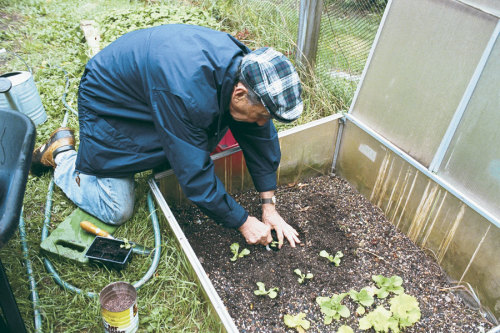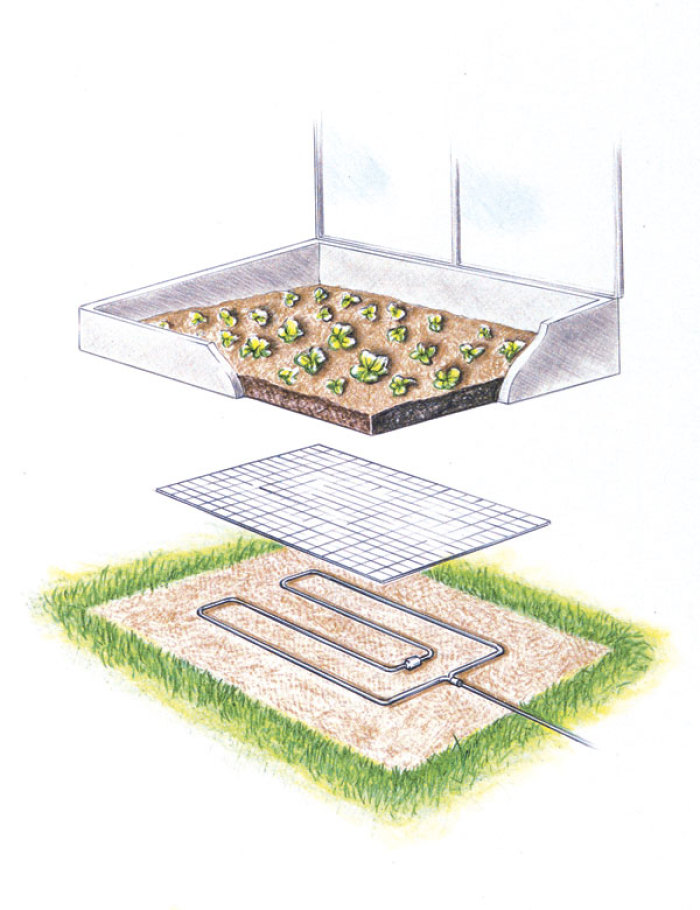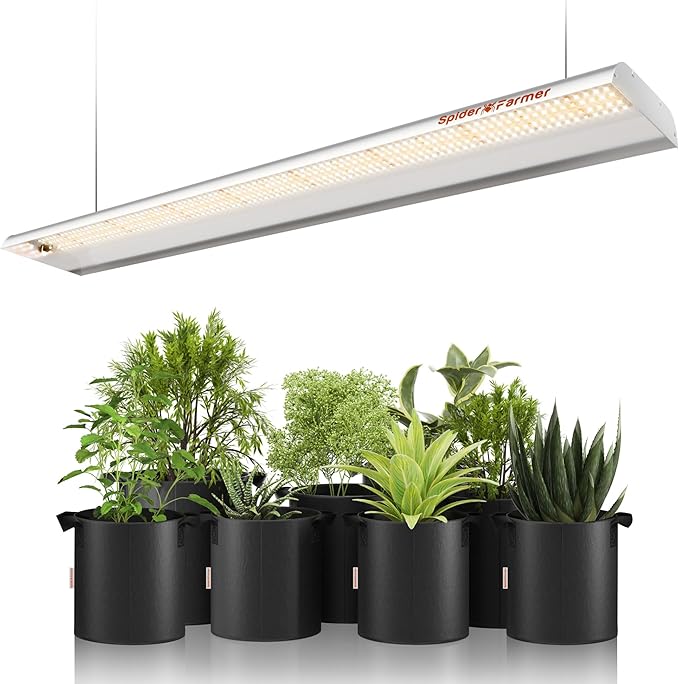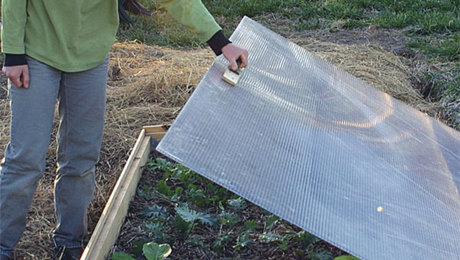
Heavy snow has fallen, burying my garden a foot deep. The temperature on this January day is 5°F. With a broom, I clear the snow from the top of my cold frame, carefully pry open the frosted lid, and look inside. Green lettuces smile up at me as fresh as on a June morning.
No magician’s “Presto!” is involved, only an underground electric cable that has warmed the soil enough for greens to thrive in the dead of winter. Such hot beds can still be created the old-fashioned way by thickly packing fresh horse or cow manure into a cold frame. But a soil-heating, insulated electric cable attached to a mat of hardware cloth and buried 3 to 5 inches deep makes for a much easier, steadier, and cleaner job. The electricity cost is only a few cents a day.
I’m a fancier of tasty, tender leaves of choice lettuce varieties and have grown many using this system. Besides Bibb, butterhead, and looseleaf lettuces, I’ve also grown arugula, beet greens, and spinach leaves to make mesclun. Call me greedy, but I want them year-round.
The big freeze is no problem in a hot box
A cold frame is a low-lying, usually bottomless box that is most often rectangular and covered with glass or plastic sashes that slope from back to front. The sun shining on the sashes heats up the inside. The electric cable provides additional heat in the soil at root level, which is especially important in mid-winter. In northern areas like mine in New York, the ground would freeze without the extra heat. But poke a finger into this warmed up soil in February and it feels as though it could be May.
You don’t have to be exceptionally handy with tools to build a cold frame. You need only join four boards together, then insert the finished enclosure a couple of inches into the ground. Depending on its size, you’ll need one or more window sashes for the transparent roof.
You can also buy frames made of aluminum and plastic whose parts fit snugly together. Such frames range in cost from $95 to $170 for single units about 3 feet long. A double unit like mine, which is more than 6 feet long, costs $310. Automatic openers also are available. Activated by temperature changes, they raise and lower top panels to keep temperatures inside the box from getting too hot or cold.
Insulated soil-heating cables, available from garden supply houses, vary in size and quality, but all are equipped with built-in thermostats preset for 70°F or so. My cable, which serves about 18 square feet of soil, cost $23. In addition, I paid $13.50 for a piece of hardware cloth—a rust-proof metal grid—cut to size at my village hardware store. I’ve had the frame for 10 years, and my first heating cable died after about five years.

Some assembly required
Diagrams come with the cable showing you how to attach it correctly to hardware cloth. The important thing is never to let the cable touch, cross, or overlap itself. This could cause it to overheat and fail. You should make a continuous loop starting and ending at the power cord connection. Make a loop around the outside perimeter, then bring the two ends of the cable towards the center of the cloth. Keep the cable at least 3 inches from itself as you create a design that will spread the heat evenly.
Fasten the cable to the hardware cloth with twine or twisties about every 9 inches as you go along. The thermostat should wind up around the midpoint of the cable configuration.
In preparation for laying the hardware cloth, dig out the soil from inside the frame to a depth of about 5 inches. Then put in the hardware cloth, making sure the cable side faces down. This will help protect against damage from cultivating tools. Cover it with the soil. I renew the soil from time to time with bags of topsoil.
For the electrical connection, I dug a hole under one end of the frame so I could bring the plug end of the heating cable outside the frame. I connect it to a heavy outdoor power cord, which I bring to the garden from a protected outlet on my house. These outdoor outlets, which take a three-prong plug, are known in the electrician’s trade as weatherproof receptacles. No further protection is needed at this end, but at the garden end, I wrap electrician’s tape around the plug and socket to keep water, snow, and ice out of the connection. To be on the safe side, though, consult an electrician about the codes applicable in your area for proper operation of outdoor appliances.
While seeding may be done directly in the frame, I prefer growing my seedlings indoors under lights for neater handling in transplanting them to the frame. I usually put in my first transplants in mid-September, but don’t turn on the electricity until hard frosts come in October. Many of these lettuces are varieties that last into December and January. I put in new plants as necessary for late winter and early spring eating. At its peak, this hot bed provides enough winter lettuce not only for me and my wife but also for my son and his wife, who live nearby.
Tips
• Knowing the square footage of the space you plan to heat will enable you to buy the right amount of cable.
• Use twine or twisties to tie the cable to the hardware cloth. This will keep the cable from crossing or touching itself.
• Probe the growing area with a soil thermometer to make sure heat from the cable is being dispersed evenly.
• Evaporation caused by the heating cable may make more frequent watering necessary.
This article originally appeared in Kitchen Gardener #19.
Fine Gardening Recommended Products

SF600 LED Grow Lights 2x4 ft
Fine Gardening receives a commission for items purchased through links on this site, including Amazon Associates and other affiliate advertising programs.

VegTrug Classic Cold Frame
Fine Gardening receives a commission for items purchased through links on this site, including Amazon Associates and other affiliate advertising programs.


















Comments
Log in or create an account to post a comment.
Sign up Log in